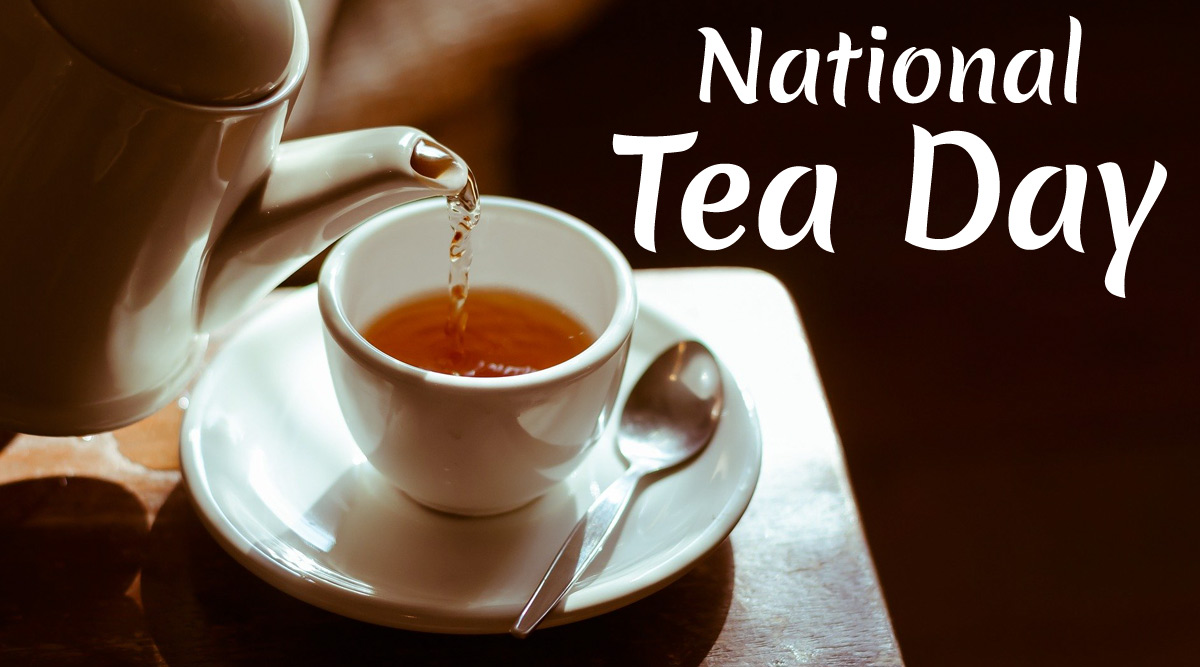
National Tea Day is a celebration that takes place on April 21st each year. It is a day dedicated to honoring one of the most beloved and widely consumed beverages in the world – tea. This special day provides an opportunity for tea lovers worldwide to come together and appreciate the rich history, cultural significance, and health benefits associated with this aromatic and flavorful drink. Whether you enjoy a soothing cup of chamomile tea before bed, indulge in a traditional afternoon tea ceremony, or savor a refreshing glass of iced tea on a hot summer day, National Tea Day is a chance to share your love for tea with others and delve into its fascinating world. In this article, we will explore 16 interesting facts about National Tea Day that will deepen your appreciation for this timeless beverage.
Key Takeaways:
- National Tea Day celebrates the rich history and cultural significance of tea, offering a chance to indulge in its soothing qualities and explore its diverse flavors and traditions.
- Tea, the second most consumed beverage in the world, provides not only a moment of relaxation but also health benefits and a connection to various cultural rituals and traditions.
Tea is the second most consumed beverage in the world, after water.
With its rich and diverse history spanning thousands of years, it’s no wonder that tea has captured the hearts and palates of people worldwide. From ancient China to modern tea ceremonies, this beloved beverage holds a special place in our daily routines.
National Tea Day is celebrated on April 21st each year.
This dedicated day provides a wonderful opportunity to embrace the magic of tea and salute its contribution to our lives. It’s a time to indulge in a perfectly brewed cup, share stories and traditions, and celebrate the soothing and comforting qualities of this ancient brew.
The origins of tea can be traced back to ancient China.
Legend has it that tea was discovered by Emperor Shen Nong over 4,000 years ago. While boiling water under a tree, a leaf from the Camellia sinensis plant fell into his pot, creating a pleasant aroma and delicious taste. And thus, the art of tea drinking was born.
There are different types of tea, including black, green, white, oolong, and herbal.
Each type of tea undergoes a unique process of harvesting, drying, and oxidizing, resulting in distinct flavors, aromas, and health benefits. From the bold and robust black teas to the delicate and grassy green teas, there is a tea variety for every taste preference.
Tea contains antioxidants called catechins, which can help boost immunity.
These beneficial compounds have been linked to various health benefits, including reducing the risk of chronic diseases, improving heart health, and promoting overall well-being. So, sipping on a cup of tea not only offers a moment of relaxation but also supports your health.
The tea industry employs millions of people worldwide.
From tea farmers and pickers to tea traders and teahouse owners, the tea industry has a significant economic impact on many countries. It provides livelihoods for communities and contributes to local economies, making tea more than just a beverage.
The United Kingdom has a rich tea-drinking tradition.
Tea time, with its scones, clotted cream, and delicate china cups, is deeply embedded in British culture. The infamous afternoon tea originated in the early 1840s by Anna, the Duchess of Bedford, as a way to curb her hunger between lunch and dinner, and it quickly became a fashionable social event.
Japan has its own unique tea culture with the revered matcha tea.
Matcha, a finely ground green tea powder, is an integral part of Japanese tea ceremonies. This vibrant green tea is prized for its intense flavor and numerous health benefits. The preparation and presentation of matcha tea are considered an art form, showcasing Japan’s appreciation for beauty and simplicity.
India is the second-largest producer of tea in the world.
With lush tea plantations in Darjeeling, Assam, and Nilgiri, India is renowned for its high-quality teas. Chai, a spiced milk tea popular in India, has also gained global popularity, offering a fragrant and invigorating way to enjoy this beloved beverage.
Drinking tea can provide a moment of mindfulness and tranquility.
Whether you are sipping your morning cup of tea in solitude or enjoying an afternoon tea with friends, tea offers an opportunity to pause, reflect, and appreciate the present moment. It’s a chance to disconnect from the busyness of life and find solace in the simple pleasure of a warm cup.
The tea bag was invented in the early 20th century.
Before the convenience of tea bags, loose-leaf tea was the preferred method of brewing. However, in 1908, an American tea merchant named Thomas Sullivan accidentally created the tea bag by packaging loose tea samples in small silk bags. This accidental invention revolutionized tea drinking and made it more accessible to everyone.
Herbal teas, such as chamomile and peppermint, are not technically teas.
While they may be steeped in hot water like traditional teas, herbal teas are not derived from the Camellia sinensis plant. Instead, they are made from various herbs, flowers, and fruits, offering a range of flavors and potential health benefits.
The art of tea blending has been practiced for centuries.
Tea blending is the process of combining different teas and ingredients to create unique flavor profiles. Blending allows tea masters to craft distinct teas with a balance of flavors and aromas, offering endless possibilities for exploration and taste experimentation.
The World’s Largest Tea Bag weighs a staggering 551 pounds!
This colossal tea bag was created in 2014 by the Chota Tingri Tea Estate in India as a celebration of their 75th anniversary. It took a team of 50 people over eight hours to brew this giant cup of tea!
Tea has influenced multiple cultural traditions and rituals.
From the Japanese tea ceremony to the Moroccan mint tea ritual and the English high tea, tea has become a symbol of hospitality, connection, and cultural heritage. These rituals showcase the intricate artistry and cultural significance tied to the enjoyment of tea.
National Tea Day is celebrated with tea festivals, tastings, and special events.
On this day, tea lovers around the world come together to indulge in all things tea-related. From tea tastings and workshops to tea-infused treats and exhibitions, National Tea Day offers an opportunity to delve deeper into the fascinating world of tea.
So, whether you prefer a cup of aromatic black tea, a delicate green tea, or a soothing herbal infusion, take a moment on National Tea Day to sip, savor, and celebrate the remarkable beverage that has brought joy and tranquility to countless lives for centuries.
Conclusion
National Tea Day is a celebration of one of the most beloved hot beverages in the world. From its humble beginnings to its global popularity, tea has become an integral part of many cultures and traditions. This article has explored 16 interesting facts about National Tea Day, shedding light on its origin, significance, and the wide variety of teas available to enjoy. Whether you are a long-time tea lover or just starting to appreciate its flavors, National Tea Day serves as a reminder to savor every cup, embrace its rich history, and discover new and exciting tea experiences.
FAQs
1. When is National Tea Day celebrated?
National Tea Day is celebrated on April 21st every year.
2. What is the significance of National Tea Day?
National Tea Day is an occasion to promote and celebrate the rich history, diversity, and cultural importance of tea.
3. How did National Tea Day come into existence?
National Tea Day was first celebrated in the United Kingdom in 2016, with the aim of spreading awareness about tea culture and raising funds for charitable causes.
4. Are there any special events or activities organized on National Tea Day?
Yes, on National Tea Day, various tea-related events and activities are organized, including tea tastings, afternoon tea parties, tea ceremonies, and workshops.
5. What are some popular tea varieties celebrated on National Tea Day?
On National Tea Day, all types of teas are celebrated, including black tea, green tea, white tea, oolong tea, herbal tea, and flavored teas.
6. Can I celebrate National Tea Day at home?
Absolutely! You can celebrate National Tea Day at home by brewing a cup of your favorite tea, trying out new tea recipes, or hosting a tea-themed gathering with friends and loved ones.
7. Are there any health benefits associated with drinking tea?
Yes, tea is known for its numerous health benefits, such as providing antioxidants, promoting digestion, boosting the immune system, and improving overall well-being.
8. How can I get involved in National Tea Day celebrations?
You can get involved by attending local tea events, supporting tea-related charities, sharing your tea experiences on social media using the hashtag #NationalTeaDay, or simply enjoying a cup of tea in the comfort of your home.
9. Can I celebrate National Tea Day outside the United Kingdom?
Absolutely! National Tea Day has gained international recognition, and tea enthusiasts from all around the world can join in the celebration.
10. Is there an official website for National Tea Day?
Yes, you can find more information about National Tea Day and its events on the official website, www.nationalteaday.co.uk.
Was this page helpful?
Our commitment to delivering trustworthy and engaging content is at the heart of what we do. Each fact on our site is contributed by real users like you, bringing a wealth of diverse insights and information. To ensure the highest standards of accuracy and reliability, our dedicated editors meticulously review each submission. This process guarantees that the facts we share are not only fascinating but also credible. Trust in our commitment to quality and authenticity as you explore and learn with us.


